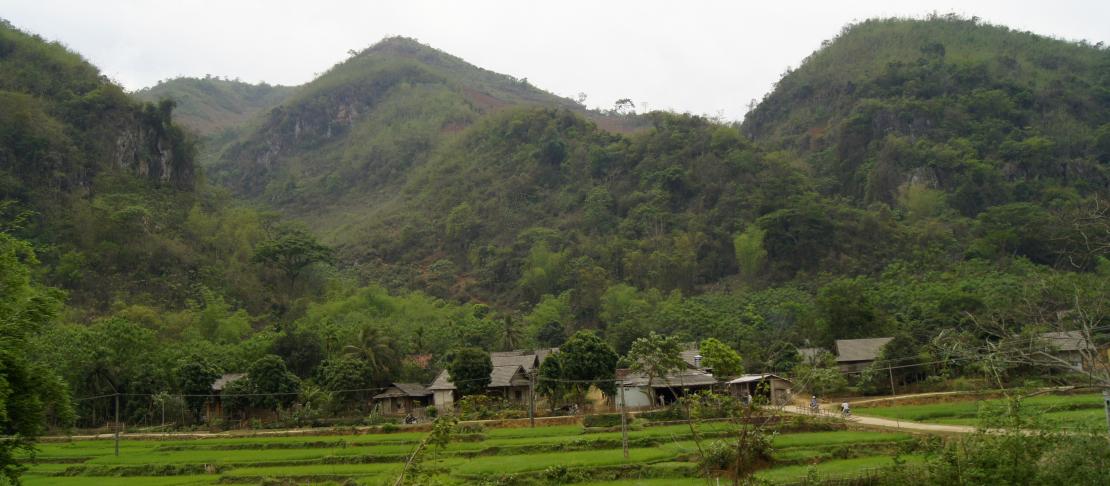What do HIV/AIDS and Climate Change have in common?

By Moushumi Chaudhury
For most of us, the obvious answer to this question is nothing. However, a field trip that I went on as part of the Community Based Adaptation 6 (CBA6) conference held in Vietnam has made me think about this question in a different manner. To gain a better understanding of community based adaptation practices, I travelled northwest of Hanoi to the Mai Hich Commune in the Mai Chau District. In this very green and mountainous part of the country, a group of CBA6 participants were exposed to the activities taking place through the “integrated HIV/AIDS prevention program for rural sustainable poverty reduction” project in the Mai Hich Commune led by Center for Community Health and Development (COHED), a prominent NGO. We were told by COHED that the largest environmental threats to the Commune are flooding, landslide caused by soil erosion, and water shortage. Agriculture is the major economic activity that many of the 30,000 people in the Commune depend upon.
Integrating health and environment activities
We were shown many activities that COHED is leading in the Mai Hich Commune. The main activity of the project is HIV/AIDS prevention and awareness considering the rate of this disease is increasing with male migration to and from urban areas where they are exposed to prostitution. However, COHED has also integrated health with climate change and development activities. These ranged from building aqueduct like structures to irrigation systems to bring in more water to agricultural fields. Farmers have had to construct such systems as an adaptation strategy due to water shortages. As another adaptation strategy, farmers have also changed from farming two species of rice to just one, and have also started to plant corn, a less water intensive crop compared to rice. Reforestation is also being promoted through a campaign to reduce soil erosion and landslides. One of the highlights of the trip was observing an evacuation drill after a simulated landslide that a group of volunteers practiced as part of the local post disaster risk reduction strategy. We also learned about energy saving technologies being used in the area, such as energy efficient stoves and biogas, which are important mitigation measures. This has reduced fuel wood use by 40% according to COHED. Finally, we visited a women’s cooperative that specialize in producing handicrafts as part of a large eco-tourism effort in the area.
Preventing HIV by improving economic opportunities
Going back to my original question, what does HIV/AIDS have in common with climate change, on the one hand the answer is still nothing since these are very different issues. On the other hand, they can be looked as part of a larger economic development challenge. A key rationale behind this project is that there is a need to create economic opportunities in the Commune so fewer men will travel to urban areas and contract HIV/AIDS. Therefore, economic opportunities such as eco-tourism and finding ways to diversify crops and still have agricultural production are ways in which COHED is trying to boost economic development in the Commune. This approach brings up several questions. At the local level, should we have stand alone climate change projects or should we support “piggybacking” of climate change initiatives on others, such as HIV/AIDS prevention? How open are funding agencies and ministries in other countries to such an integrated approach as in the case of Vietnam? Does a separate climate fund make sense or should we combine climate and development funds?
This COHED led project that I have been thankfully exposed to, reinforced my belief that separating climate from development projects may actually not be a good idea, especially if we are targeting the same stakeholders at the grassroots level. It may actually force funding agencies and ministries to work together, which sometimes seems impossible. My experience in the Mai Hich Commune in Vietnam has also shown me that adaptation and mitigation practices, which we sometimes separate as two very different approaches to climate change solutions, can actually be integrated into a larger development project quite successfully. So the answer to my question is that, yes, HIV/AIDS and climate change do have something in common – they can both be combined into a larger development portfolio that addresses multiple challenges simultaneously potentially saving us time and transaction costs in setting up various independent projects. Mai Hich Commune has certainly provided an example of a good practice in climate and development project design to be studied and praised.
This blog story was written by Moushumi Chaudhury, CCAFS Science Officer, Theme 4.1: Linking Knowledge with Action. More updates from the Community Based Adaptation conference will be posted on this blog, on twitter @cgiarclimate and the CCAFS facebook page.


